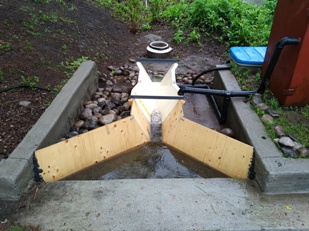Evaluating how bioretention evolves over time
 This study examined the changes in bioretention water quality and quantity performance over a five year time period. The bioretention cell evaluated was constructed in late 2012 at the TRCA’s Kortright Centre. It was first monitored intensively by STEP in 2013/14 as part of a study comparing the performance bioretention to that of a neighbouring infiltration trench under the same drainage conditions. During the initial study, the media was freshly placed and the plants had still not fully developed. Researchers from the University of Toronto returned to the site in 2017 once the bioretention had matured to evaluate what changed five years later.
This study examined the changes in bioretention water quality and quantity performance over a five year time period. The bioretention cell evaluated was constructed in late 2012 at the TRCA’s Kortright Centre. It was first monitored intensively by STEP in 2013/14 as part of a study comparing the performance bioretention to that of a neighbouring infiltration trench under the same drainage conditions. During the initial study, the media was freshly placed and the plants had still not fully developed. Researchers from the University of Toronto returned to the site in 2017 once the bioretention had matured to evaluate what changed five years later.
The results were encouraging. Despite the presence of fine textured native soils, most of the runoff into the facility continued to be either infiltrated or evapotranspired. Outflows accounted for only 5% and 8% of total inflows in 2013/14 and 2017/18, respectively. While water quality results were mixed, with some variables increasing and others remaining the same or decreasing over the 5 year period, effluent concentrations of total suspended solids remained largely the same. There were also fewer spikes of solids, total nitrogen and dissolved and total phosphorus in the mature bioretention, likely due to stabilization of the media.
For more details, see the download link in the right side bar to access the full article.
